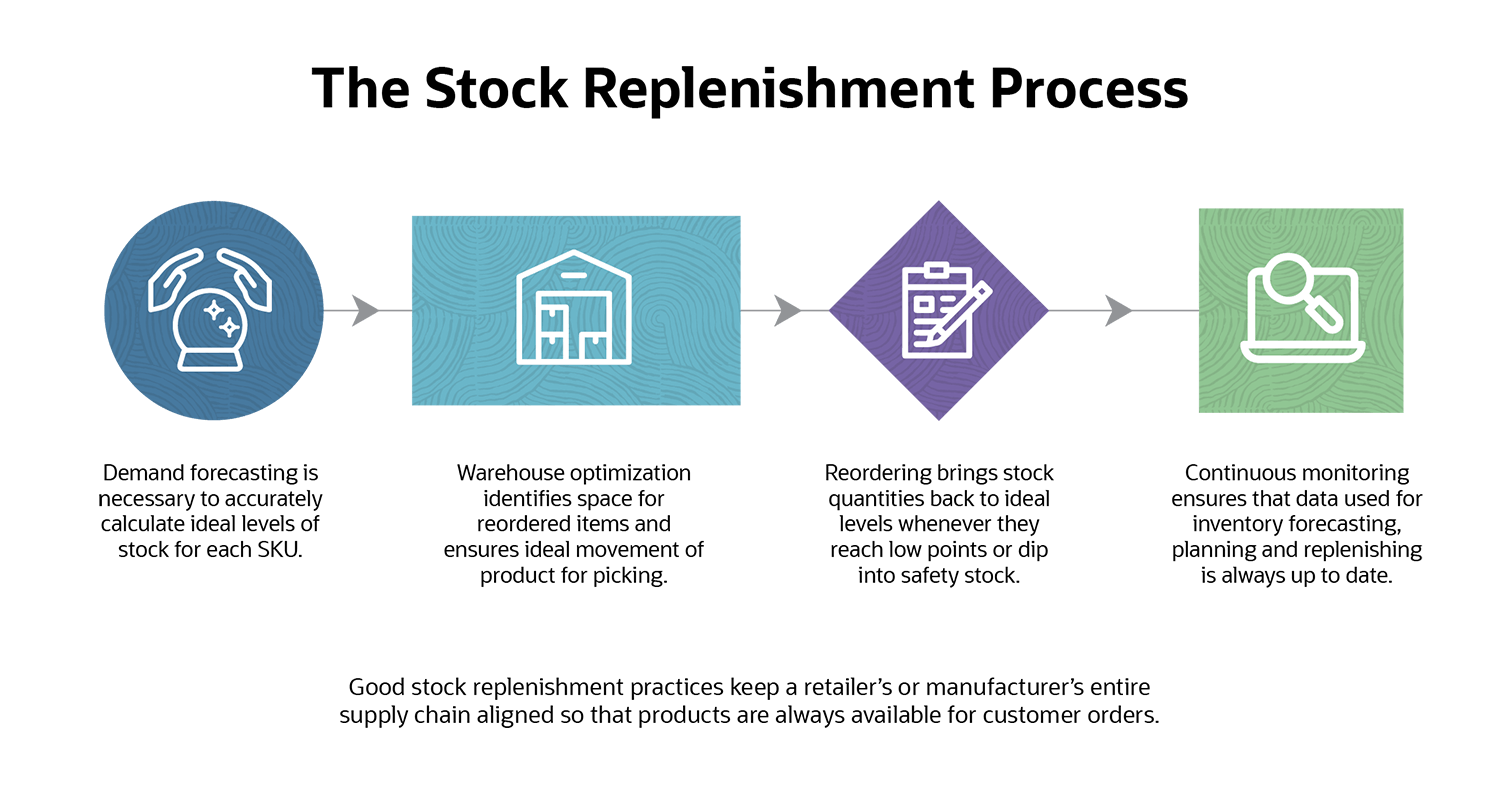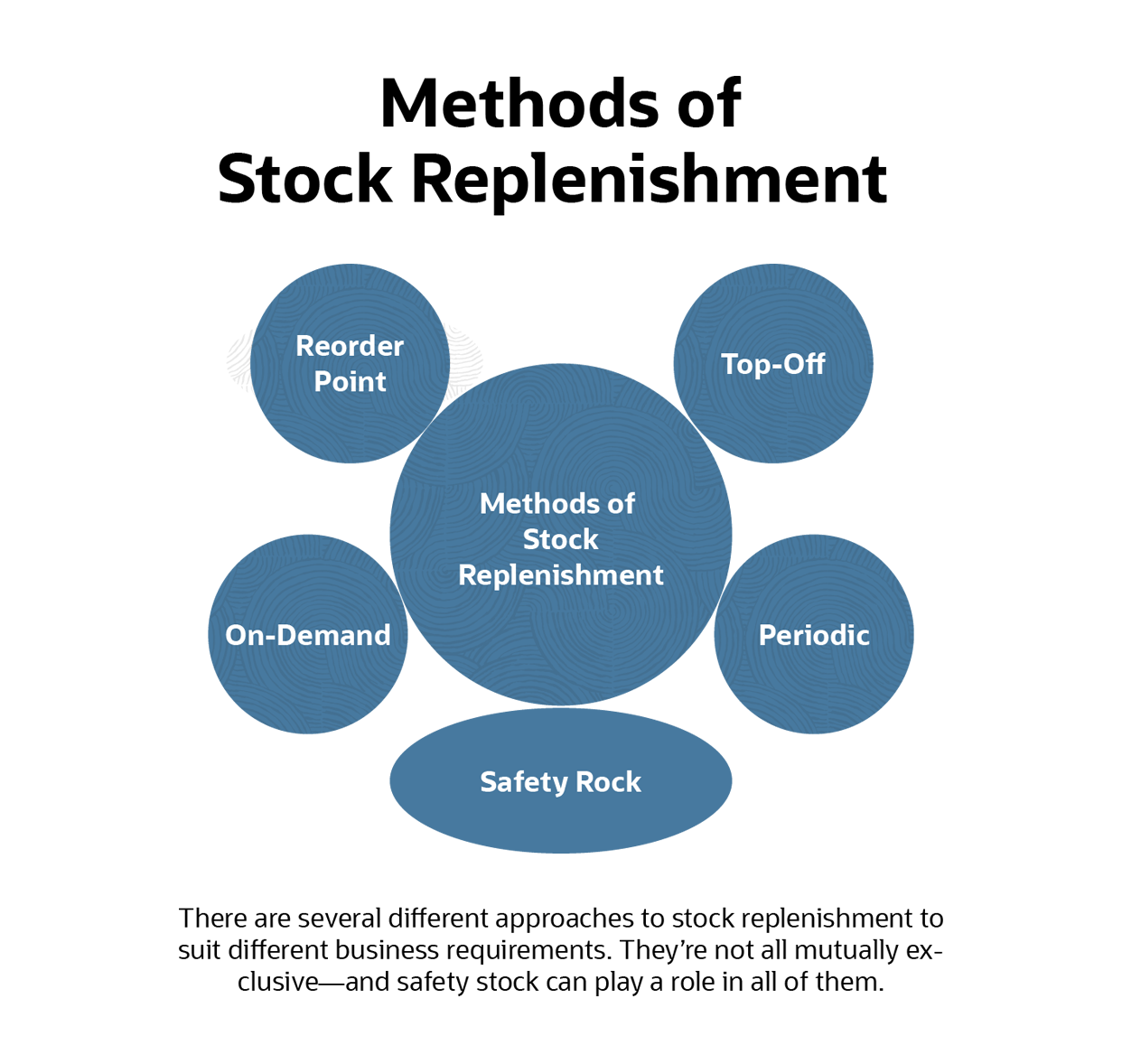Every salesperson knows that having the right amount of product in stock at the right time is crucial. Too much stock, and the company must pay for extra storage, risks losing products with short shelf lives or ends up stuck with unmoving products on shelves for a long time. Too little stock, and the company could lose customers due to shipment delays and stockouts.
The goal should always be to have product moving through the supply chain in a way that keeps costs as low as possible without hindering customer experience, with raw materials or finished items reordered at exactly the right time to maintain optimal flow. Stock replenishment is the process by which companies try to achieve that goal, usually assisted by inventory management software that can automate stock replenishment processes.
What Is Stock Replenishment?
Stock replenishment — also known as inventory replenishment — entails moving items along the supply chain at an optimal rate to both meet customer demand on time and keep inventory costs low. Reordering materials or products, moving them from reserve to primary storage or from storage to warehouse order-picking locations are all part of the stock replenishment process that keeps products flowing.
Key Takeaways
- Stock replenishment is a process that ensures product flows through the supply chain at an optimal rate for fulfilling orders while holding costs low.
- Demand forecasting and optimization of physical storage space are good first steps for an effective stock replenishment process.
- Stock replenishment can occur periodically — i.e., inventory assessed and reordering done at the end of preset intervals — or on demand, where reordering is based on more immediate customer demand.
- Inventory management software can assist with stock level calculations, monitoring of stock and overall end-to-end inventory visibility.
Stock Replenishment Explained
Stock replenishment helps ensure that the right amount of inventory is available for sale at the right time. Its aim is to keep inventory holding costs as low as possible for the company and optimize stock levels to fulfill customer orders, with no overstock or stockouts. The stock replenishment process dovetails with demand forecasting and physical storage space considerations because it includes deciding how much stock to hold for each item; how much to reorder, and when; and when to move inventory from the reserve or “back” stock to the active stock or picking areas of a warehouse or distribution center.
Each company must establish its own rules and methods for stock replenishment. It’s important to consider customer demand forecasts and the company’s working capital when optimizing inventory levels, and to prioritize high-value stock keeping units (SKUs).
Why Is Effective Stock Replenishment Important?
Effective stock replenishment ensures that goods flow efficiently throughout the supply chain. For retailers, the ultimate goal and importance of effective stock replenishment is to secure customer satisfaction by having the right product in stock for timely shipping and delivery when the customer needs it. For manufacturers and others in earlier stages of the supply chain, the importance of a well-implemented stock replenishment strategy translates into preventing costly delays in production, enabling the reordering of products with satisfactory lead times and maintaining cost-effective inventory levels.
Smart stock replenishment also positively impacts a company’s finances by prioritizing the investment of working capital for high-demand items, avoiding extra holding costs of obsolete stock and preventing customer loss due to stockouts.
How Does Stock Replenishment Work?
If a company that sells goods has been in business for a while, they’ve done some kind of stock replenishment even if they don’t think of it that way. But knowing more about the usual steps for an effective stock replenishment process can be key to eliminating many inventory management problems.

Stock Replenishment Process
Good stock replenishment processes can vary widely from one company to another, since some consumer products may sell by the millions and have lead times measured in days, while other, bigger-ticket items that sell in single digits have lead times measured in months. But they all must begin with a keen understanding of demand for the product in question. Here’s a typical four-step stock replenishment process:
-
Demand forecasting. Businesses should have the most accurate picture possible of future customer demand for each of their SKUs. With a clear understanding of demand, companies can better calculate how much stock to reorder, and when. Good demand forecasts also improve other aspects of inventory planning, helping organizations to clearly define things like the maximum and minimum quantities to hold in storage, warehouse optimization, prioritization of items, etc.
-
Warehouse optimization. It’s unwise to reorder stock unless you’re certain there will be physical space for the inventory when it arrives. Planners should reserve enough space to hold the ideal amount of each SKU, along with optional safety stock. It’s important to consider shelf life and demand rate when planning physical storage space — high-turnover items should be easily reachable, for example, for a lean order-picking process.
-
Reordering. Once the numbers are crunched and the warehouse is optimized to receive and hold the ideal quantity of product, it’s time to reorder items. Reordering might be periodic for all items or on-demand for each SKU.
-
Continuous monitoring. As with most inventory management tasks, the stock replenishment process needs continuous monitoring to stay effective and up to date with demand. Software can assist tracking and reporting of inventory management key planning indicators (KPIs) used to plan and improve stock replenishment.
Methods or Principles of Stock Replenishment
Stock replenishment methods and numbers are different for each company. Factors like size of business, seasonality and physical storage space, for example, are considered when choosing a strategy for reordering stock or replenishing picking facilities. Here are some principles and methods of stock replenishment:
- Safety stock. Also called “buffer stock”, safety stock is one of the first things that comes to mind when considering how to optimize inventory levels and when to replenish stock. It means holding a reserve of stock in case of shortage, supplier delays or an unexpected spike in demand. Ideally, safety stock can carry a company through a hiccup in its stock replenishment cycle without substantially increasing holding costs. There are many different ways to calculate the amount of safety stock any given company might need, but they all generally focus on variables having to do with an item’s daily sales (e.g., average, minimum, maximum) and the lead time required from ordering to availability for sale.
- Reorder point. This method consists of monitoring inventory levels and reordering items once they fall to a certain number, called a reorder point. While it’s possible to manually apply this method, it’s usually used on automated systems that trigger reordering automatically when stock levels reach the reorder point. Safety stock numbers, as well as lead time, are necessary to figure out the ideal reorder point for each SKU in inventory.
- Periodic stock replenishment. Often considered an ideal method for restocking large-capacity warehouses, this strategy means exactly what it sounds like: Inventory is checked and replenished at specific periods. Whatever interval for inventory counting a company chooses, if stock levels are satisfactory no reordering is necessary. A downside of the periodic method is that if demand changes between counting dates, the company might not know it until the next cycle review, increasing the risk of stockouts.
- Top-off replenishment. Also called “lean time replenishment”, this method works well for businesses with fast-moving SKUs. It consists of moving inventory from storage to picking areas during periods of slack demand, thus improving efficiency during peak picking periods.
- On-demand replenishment. This method simply replenishes stock replenishment based on demand — in other words, as customers take products off the shelf. It’s usually practiced by smaller businesses and retailers. They may still choose to hold safety stock, but reordering and restocking are limited to fulfilling current orders and any orders anticipated by demand forecasting. Slow-moving items are usually deprioritized in this approach.

Stock Replenishment Best Practices
An effective inventory replenishment process requires careful planning and a healthy overall inventory management strategy. Here are some worthwhile best practices to consider for planning and maintaining efficient stock replenishment:
- Continuous assessment. Even when a stock replenish method has already been implemented, it’s important to continuously monitor inventory KPIs and reassess forecasts to make sure that the chosen method is still the most effective for the business.
- Counting. It may seem simple, but stock counting performed on a regular basis is an indispensable inventory control practice that can promote successful stock replenishment. Whether physical counting or cycle counting is preferred, information about inventory levels needs to always be updated to support accurate planning, which, in response, triggers effective replenishment.
- Choosing the right method. The process for replenishing inventory should be tailor-made for each company. Consider the size of the business, the amount of working capital and the size of physical storage or warehouse.
- Keeping safety stock. Again, while optional, calculating and keeping safety stock is a widespread practice that can be used with any of the replenishment methods. It’s an extra layer of security against stockouts.
- Building good supplier relationships. Open communication with suppliers can provide an essential boon for reordering and replenishment processes. Delays risk creating stockouts; having an open line of communication in which suppliers can give a heads-up if something changes on their end might help in emergency situations.
5 Stock Replenishment Tips
The common practices above help businesses of all sizes. The stock replenishment process may seem overwhelming for younger and smaller businesses. Here are a few extra tips to keep in mind:
- Keep reliable suppliers. It’s important to monitor the reliability of suppliers. When choosing or changing suppliers, consider not only price but quality of the product, expected lead times and consistent on-time delivery. When dealing with must-have items, backup suppliers decrease the risk of stockouts.
- Let back orders trigger reordering. When stockouts do happen and a client ends up back-ordering a product, companies can choose to reorder the usual amount of product to bring their stock level back to ideal. That’s a good plan B for unanticipated demand or when periodic stock replenishment warehouses run out of product before the end of the cycle.
- Maintain end-to-end inventory visibility. Having all the information in one centralized database is best, but even with manual inventory management, thorough visibility is key for effectiveness. Make sure to keep all relevant personnel updated on forecasting, quantities, locations and strategies.
- Automate. Streamlining and automating inventory management makes the stock replenishment process easier and less prone to human error. Companies may choose software functions that allow them to calculate ideal inventory levels and reordering intervals and to visualize inventory throughout multiple warehouses.
- Don’t forget the bigger picture. Reordering and replenishing stock are just part of the inventory management process. Effective inventory planning, demand forecasting, picking strategies, warehouse receiving processes and supplier relationships are all necessary for profitable operations that lead to customer satisfaction.
Improve & Manage Stock Replenishment With NetSuite
NetSuite Inventory Management provides a real-time view of inventory across multiple warehouses and sales channels. That allows for optimization of inventory levels throughout the enterprise, freeing up capital that might otherwise be wasted on purchasing and holding surplus inventory, or on trying to win back customers lost due to stockouts. In addition, automated inventory tracking provides planning teams with the most up-to-date information and KPIs, helping them more accurately forecast demand and, subsequently, calculate the ideal levels of stock for each SKU available for sale.
In addition, NetSuite’s software considers fluctuations in demand, supply chain logistics and seasonality, among other factors, to ensure that its automated recommendations maintain ideal inventory levels. Its automation also allows for dynamic reorder points by using historical and seasonal data in its replenishment calculations and helps avoid delays due to human error by generating tasks and alerts ahead of reordering and replenishment deadlines.
Conclusion
Whether periodic or on demand, the stock replenishment process is central to every business that sells goods to customers. Businesses often see stock replenishment planning as too challenging for something that supposedly happens organically, but the way it is approached by the inventory management team can make or break a business’s endeavor to generate high customer satisfaction.
Award Winning
Cloud Inventory
Stock Replenishment FAQs
What is the stock replenishment process?
The stock replenishment process consists of reordering product when stock levels are low and moving items from reserve inventory to main inventory or picking areas. Its goal is to ensure that products are moving through the supply chain, while keeping inventory at ideal levels to prevent stockouts and costly overstocking.
How do you replenish stock levels?
After forecasting demand and appraising ideal stock levels, a company may choose to reorder product to replenish inventory periodically or on demand. Continuous monitoring of inventory levels and keeping a safety stock are also elements of stock replenishment.
Is stock replenishment easy?
Stock replenishment should be tailored to the needs of each company. This can be a timely and systematic process — and also time-sensitive, as companies do not want to run into stockouts caused by poorly planned inventory. Stock replenishment can be made easier and less prone to human error with the assistance of inventory management software.









